
I’m starting to get hungry…
Henry of Skalitz
In no game character is hunger as frequent as Henry from Skalitz, our protagonist. His persistent rumbling stomach asking for a bite may soon become tiresome to you. Yet, just as Henry is always famished, we too eagerly anticipate his next escapades.
In essence, Kingdom Come: Deliverance II represents the realization of a dream for an immersive adventure in the medieval era. Or put another way, it’s the long-awaited revisit to this world because the Czech megaproduction appears to have most of the qualities of a perfect sequel. It directly continues the storyline of the first Kingdom Come, expands upon it, and enhances various aspects, at least that’s what it seems for now!
For other games, initial impressions are typically formed after 2-4 hours of playtime. However, in the case of Kingdom Come: Deliverance 2, it took me nearly 30 hours to form these impressions! This isn’t due to a slow start, but rather a reflection of my feelings until reaching a pivotal point in the storyline. Granted, you could reach this point in about 8 hours. But thanks to the developers generously providing a full month for review, I was able to complete most, if not all, side quests in the first region of the map. I only wish there were more such quests available.
Interrupted story continues
In the sequel titled “Kingdom Come: Deliverance 2,” Hans Capon, accompanied by Henry of Skalitz and his companions, embarks on a journey towards Trosky castle. Their mission is to deliver a letter to Otto von Bergow, seeking clarity about his stance amidst the country’s tumultuous times. The Czech Kingdom stands divided; some nobles rally behind the imprisoned King Wenceslaus IV, while others support Sigismund of Luxembourg, who now holds the throne. As Henry navigates these challenging circumstances, he grapples with personal struggles and a thirst for vengeance. While a thorough understanding of the first game in the series would enhance the experience, developers have made concerted efforts to bring new players up to speed on the events from the initial installment.
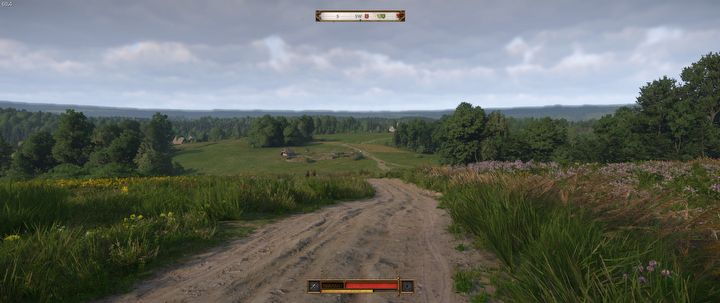
In the initial stages of the game, all relevant details were seamlessly incorporated. Throughout his journey, Henry encounters vivid dream sequences that allow him to share past events with new acquaintances, including pivotal decisions he made. These experiences don’t impact his stats in the new game except for one occasion where we choose his starting pool – it serves as a memory aid or learning tool for the storyline of the first part. While new players will grasp the primary themes of the initial installment, it should be noted that not every subtlety can be conveyed, such as the profound emotions that persistently haunt Henry.
Regardless of the detailed introduction, ultimately, you find yourself with entry to an expansive open-world region close to Trosky castle. The developers masterfully tackled Henry’s character progression by strategically explaining why we must initially collect experience across various domains and simultaneously establish our standing among the locals (either positively or negatively based on our decisions and actions).
Fight for balk wins over saving the world
You have the freedom to dive right into the main missions, which eventually branch off into two different directions. It’s not necessary to focus solely on one path – in fact, it’s advisable to finish both, making your decision between them at the final juncture. Since the plot seems to slow down at times, spending time on side quests will definitely enhance Henry’s combat skills and other abilities, which will prove helpful as you progress further in the game.
In a manner similar to the original version, the primary character learns abilities that are useful to him rather than acquiring skills that he doesn’t use. For instance, if we spend twenty hours without practicing archery, stealth, lock-picking, or improving our charm, we could encounter a challenge in a crucial moment where these skills would make a difference. Learning can also be facilitated indirectly by investing in training and reading relevant books – unfortunately, the option to engage in more productive reading “on the throne,” even for the king, has been taken away in KCD2.
Luckily, life within Bohemian Paradise kept me thoroughly occupied during this initial phase. There were countless tasks I undertook for myself and the community, ranging from carrying bags to joining tavern brawls, pursuing poachers, searching for lost sheep in the woods, warding off wolf attacks, digging graves, transporting decaying animal carcasses to the gravedigger, mediating a land dispute among farmers, and intervening in a nomadic Romani family’s disagreement. I could go on about the other miscellaneous activities as well.
The captivating world of Bohemian Paradise kept me engrossed during its initial stage. There were numerous chores I took upon myself for my own sake and for the residents, including carrying bags, joining a tavern fight, tracking poachers, searching for lost lambs in the forest, protecting against wolf attacks, digging graves, moving rotting animal carcasses to the gravedigger, resolving a farmers’ land dispute, and mediating in a Romani family’s conflict. I could list many more tasks as well.
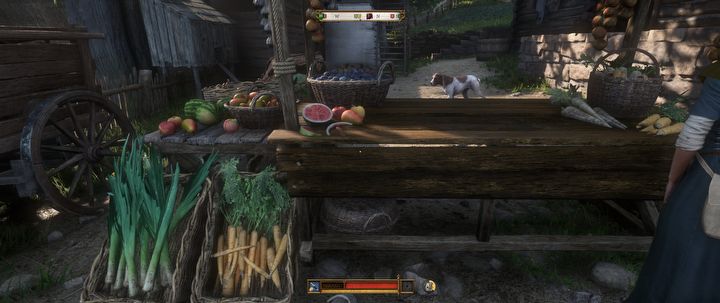
As a gamer, I appreciate the authenticity that the quests in Kingdom Come: Deliverance 2 offer. Unlike other games where I’m often saving worlds or activating magical artifacts, here I find myself doing ordinary tasks like carrying bags of flour or buying a dress for a wedding – things that feel real and relatable. In contrast, Dragon Age: The Veilguard seemed to have quests that felt forced and similar to each other. Instead, in KCD2, I’m deeply immersed in the everyday life and struggles of medieval society, making the experience more engaging and believable.
Furthermore, what might initially seem like a straightforward endeavor can unexpectedly transform into an intricate, multi-act saga with a thrilling climax. Sometimes it’s a breathtaking cinematic scene, other times a gruesome battle. To some degree, we have leeway in achieving our objective: depending on Henry’s abilities or decisions, you can choose diplomacy, stealth, or brute force. The outcome is typically consistent, save for instances where life or death is at stake (at least during the part of the game under discussion). A dash of unpredictability, however, comes from a swift journey, as then unexpected encounters may arise along the way.
A bit new, a bit old-fashioned
As a gamer, I’m thrilled about the sequel! It’s packed with neat tweaks and enhancements that make gameplay smoother than ever. Now, I can effortlessly switch between multiple outfits with just one key press – imagine having heavy armor for tough battles and a stealthy suit for sneaking around undetected, all at my fingertips!
Additionally, I can now equip belts and satchels to carry an array of weapons, food, or potions without fumbling through menus. These items are readily accessible whenever I need them, adding a layer of convenience that’s hard to beat.
The game world feels more vibrant with the addition of dryers and smokehouses, which help keep my supplies fresh for longer periods. And let’s not forget about the awesome feature that allows my companion to automatically follow me during quests – whether on foot or horseback. This feature streamlines the questing experience and makes exploration feel more immersive than ever!
In the past, alchemy and sword sharpening remained unchanged. However, a fresh addition has been introduced: blacksmithing. This is an intricate minigame with multiple stages. Initially, we heat up the material, then shape it, ensuring balanced strikes from both sides throughout its length, and finally harden the finished item.
So far, I haven’t found any significant use for blacksmithing – I haven’t come across a recipe to craft a special sword or axe that would boost my combat abilities, but the items made can still be sold for a profit. Yet, there is a meditative quality to the process of forging itself, and sometimes it’s enjoyable just to create something as a form of relaxation.
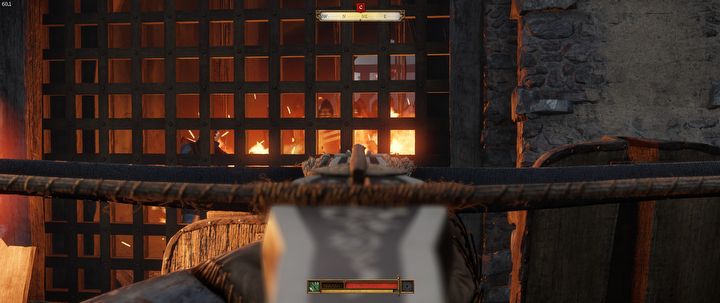
In this updated version, let me rephrase: The contentious points persist, which may displease certain individuals: saving and bypassing locks. The necessity for a “saving schnapps” or a “savegame remedy” beverage to preserve the game remains unchanged, yet there’s always the quick “save and quit” alternative – thus, not carrying alcohol in the inventory isn’t as much of an inconvenience as it was during the early stages of the first version.
As a gamer, I’ve found that cracking tough locks often boils down to a roll of the dice if my thieving skills aren’t up to par. These intricate devices quiver so much that success largely hinges on luck. It’s definitely worth spending time mastering stealth and dexterity. At my skill level, I can eventually open challenging locks with repeated attempts, but only using a keyboard – I struggle significantly when trying with a controller.
He who fights with a sword, dies by Mutt
In the sequel to Kingdom Come: Deliverance, the fighting mechanics have undergone slight modifications and been enhanced with an assortment of fresh weapon choices. The selection of attack angles has been narrowed down, and for keyboard and mouse control, the block function has been shifted from the Q key to the right mouse button. It seems that there are a variety of clinch, close combat movements, although I may have overlooked them in the initial game where my focus was predominantly on the bow. Generally, combat feels more streamlined and user-friendly, but during mass battles, it can still seem somewhat chaotic, especially when we’re in close proximity to enemies. The system functions optimally when it can lock onto one enemy or, at most, two. Sword fights have seen improvements with the addition of more immersive sound effects and spark scattering.
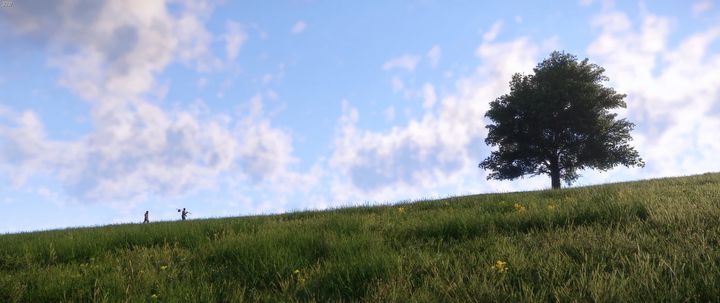
Henry has acquired the skill to silently take down opponents, either rendering them unconscious or ending their lives with a dagger. This is executed in a more authentic manner compared to other games, similar to fencing. Occasionally, characters can manage to escape from the grip and defend themselves. Archery remains as it was – there are no magical aiming markers on the screen, we still aim using the arrow tip, considering gravity. It’s simpler to aim with a crossbow – a novelty in the game; however, this weapon demands a long draw and at my current skill level, it’s not effective against enemies due to the inability to “one-shot” them. Until a certain storyline progression, no homemade firearms appear. Interestingly, our canine companion – Mutt, proves to be an efficient weapon, capable of targeting specific opponents and defeating them.
Bugs and optimization – is it better?
In the latest release of Kingdom Come, there were quite a few glitches at launch – but it seems to have improved considerably. I didn’t come across any bugs in quests or scripts during my playthrough. However, I did encounter an issue where a boulder in the forest wasn’t properly set up as a collision object, enabling me to walk through it and fall into a depression in the terrain, making it difficult to escape. There are also instances of floating objects or clumps of grass here and there, but these are exceptions rather than the rule on an expansive map.
This new edition has noticeable improvements on a small scale, particularly in lighting, character models, and detailed elements like facial expressions, clothing, and props. The forest and building textures from the first installment remain impressive. The animations of characters are significantly better, and the cinematography in cutscenes showcases great skill and artistry, with many elegant and artistic shots. However, some conversations with NPCs may appear static due to the camera focusing on their heads, a common style in Bethesda games. Yet, the ability to interact with them anywhere, regardless of their activities, helps justify this decision. During plot-driven cutscenes, the full dynamics are already in play. Furthermore, the captivating soundtrack continues to impress and offers endless replay value.
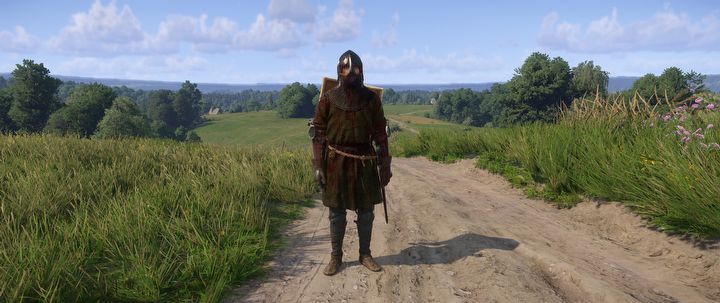
On my computer equipped with an RTX 3070 GPU, i5-10600 processor, and 32GB RAM, the game runs steadily at about 60 frames per second at high settings, except for occasional momentary hiccups during autosave. I believe that better optimization was achieved through various techniques, as the distant tree edges appear slightly less sharp in this version compared to the first installment – even with DLSS disabled. While riding a horse, there might be some infrequent and selective appearances of shadows or sharper textures in the far background, but they are not frequent enough to cause concern.
As a gamer, I’ve been tweaking settings to maintain a smooth 60 FPS experience in this open-world game. Ramping up textures from “high” to “very high” works great in vast landscapes, but the frame rate dips to around 40-50 when I enter villages, especially when there are large groups of NPCs gathered. So far, I’ve only explored open spaces like forests, meadows, fields, and small villages within the Bohemian Paradise, avoiding intense battles and the bustling city of Kuttenberg. We’ll see how it holds up as I delve deeper into this game!
“Hey, this is my bed!”
Currently, there’s an issue I’ve noticed: The game’s reputation system seems unrealistically rigid. For instance, if we save someone’s life and are rewarded with money, gifts, and heartfelt gratitude, it feels inconsistent that a small action like borrowing a spoon or using their bed can lead to harsh words and the threat of punishment. I understand that these rules prevent Henry from disrupting the NPCs’ daily routines within the game, but there could be a more harmonious solution, perhaps by relaxing some restrictions when completing a quest for someone and gaining reputation. A simple warning like “Hey, this isn’t your bed” would feel more fitting than insults and the threat of arrest. Additionally, I find the dialogue options that suggest choice but lead to only one outcome to be misleading.
In my view, the level of blood shown on the screen requires adjustment. It seems that the depiction of sword and axe fights might have been intense, but it appears as if Henry is causing an excessive amount of gore during conversations, which I find overly graphic for my preferences. Additionally, I wasn’t fond of the inclusion of wolves in the forest wildlife. Although hunting is no longer necessary for quests, wolves and even wild dogs can sometimes function as main adversaries. This leaves me uncomfortable with having to resort to violence against them. A mechanic allowing players to scare them off using a torch would be beneficial.
Despite some minor criticisms, Kingdom Come: Deliverance 2 has not disappointed me so far. I was already impressed with the game from the Czech developers back in 2018, and my admiration remains. The comments here are based on a few side quests, not including the main storyline or continuation of the quests, but I have high hopes that the developers will surpass themselves in those areas. I’m eager to find out if the sequel will maintain the monastery living motif from the first part! With 30 hours played, it feels like just the start, and the main event is yet to unfold!
Read More
- INJ PREDICTION. INJ cryptocurrency
- SPELL PREDICTION. SPELL cryptocurrency
- How To Travel Between Maps In Kingdom Come: Deliverance 2
- LDO PREDICTION. LDO cryptocurrency
- The Hilarious Truth Behind FIFA’s ‘Fake’ Pack Luck: Zwe’s Epic Journey
- How to Craft Reforged Radzig Kobyla’s Sword in Kingdom Come: Deliverance 2
- How to find the Medicine Book and cure Thomas in Kingdom Come: Deliverance 2
- Destiny 2: Countdown to Episode Heresy’s End & Community Reactions
- Deep Rock Galactic: Painful Missions That Will Test Your Skills
- When will Sonic the Hedgehog 3 be on Paramount Plus?
2025-01-10 19:02